33+ Sample Parenting Plan Templates
-

Sample Parenting Plan Template
download now -
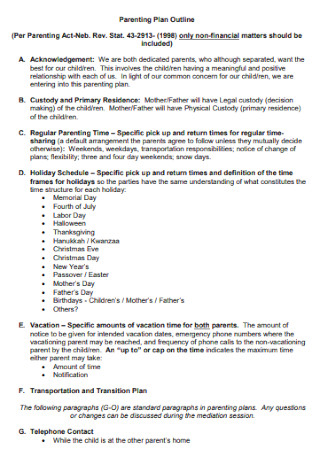
Parenting Plan Outline
download now -
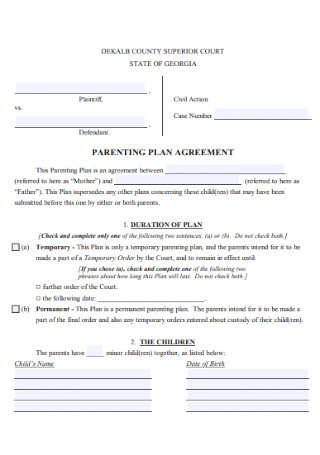
Parenting Plan Agreement Template
download now -
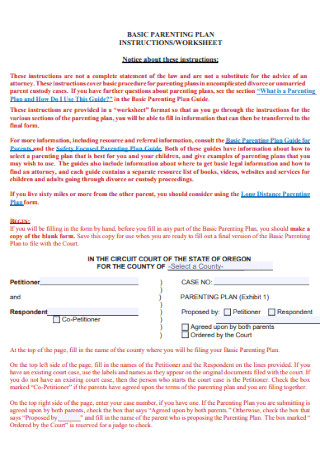
Parenting Plan Worksheet Template
download now -

Basic Parental Plan Template
download now -
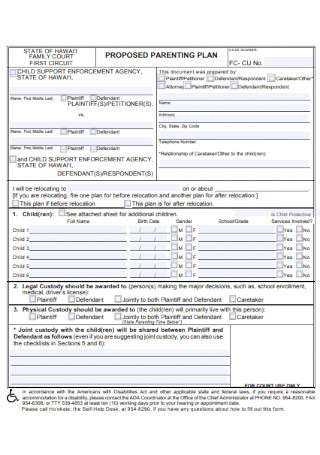
Proposed Parental Plan Template
download now -

Standard Parenting Plan Template
download now -
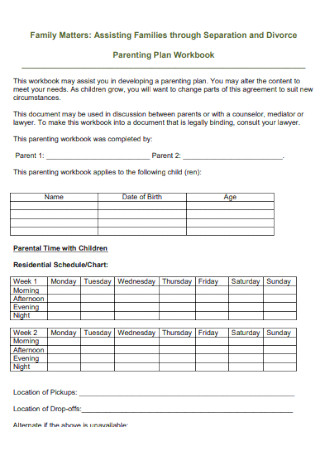
Family Parenting Plan
download now -
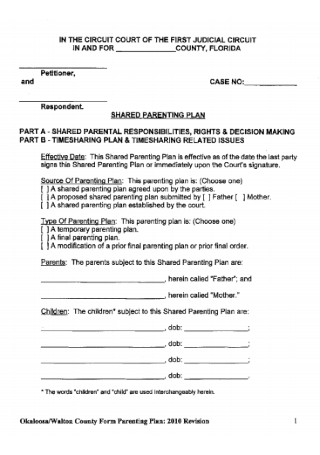
Shared Parenting Plan
download now -
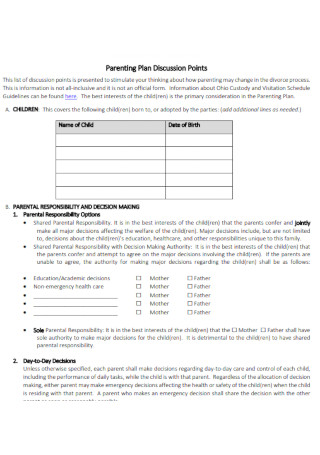
Parenting Plan Discussion Points Template
download now -
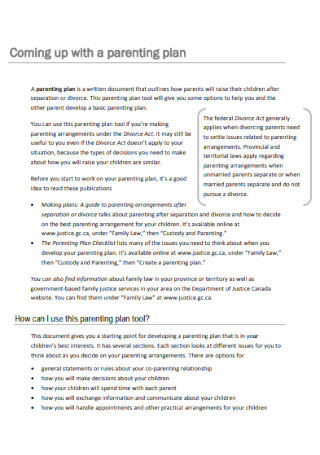
Simple Parenting Plan Template
download now -
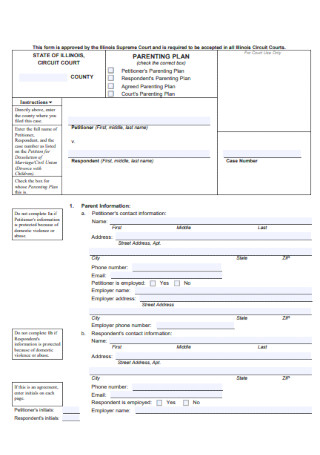
Formal Parenting Plan Template
download now -
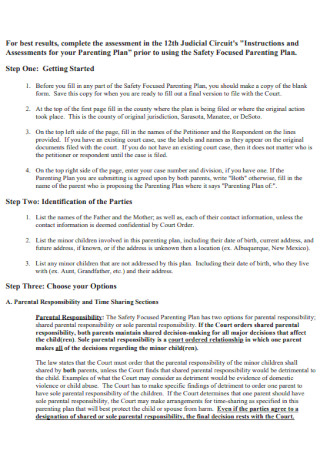
Safety Parenting Plan Template
download now -

Family Court Parenting Plan
download now -
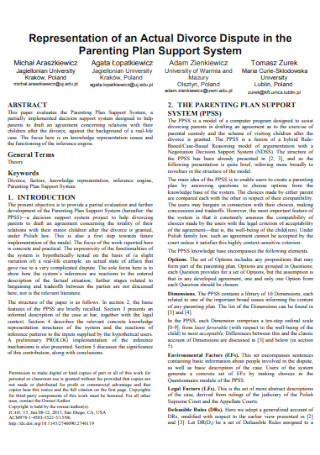
Parenting Support System Plan
download now -

Parenting Tool Plan Template
download now -
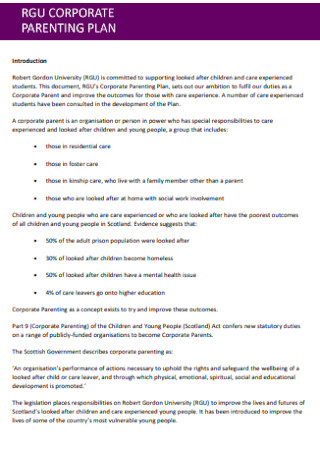
Corporate Parenting Plan Template
download now -
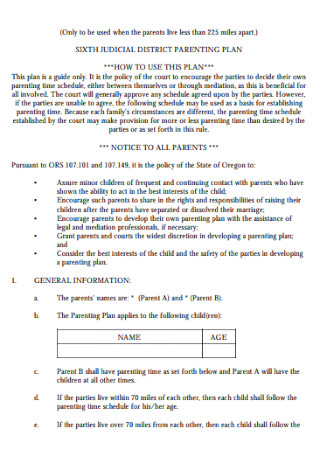
Sixth Judicial District Parental Plan
download now -
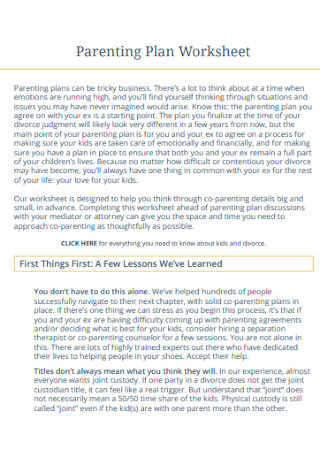
Parenting Plan Worksheet Example
download now -
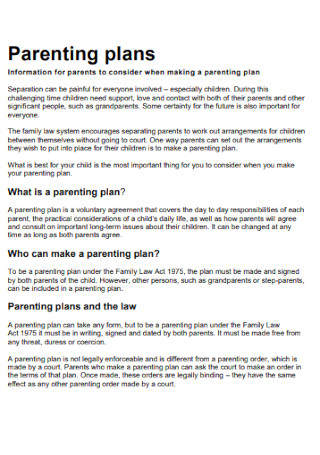
Parenting Plan Format
download now -
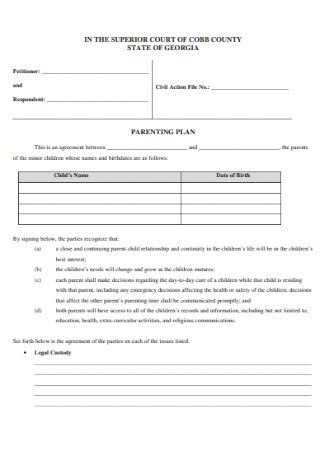
Printable Parenting Plan Template
download now -

Parenting Plan Checklist Template
download now -
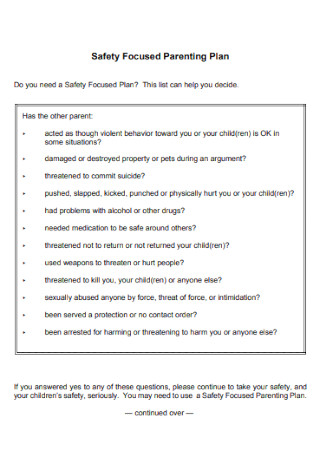
Safety Focused Parenting Plan
download now -
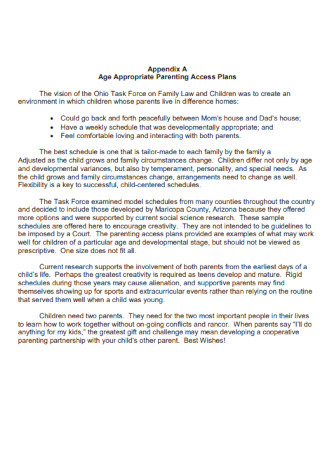
Parenting Access Plans
download now -
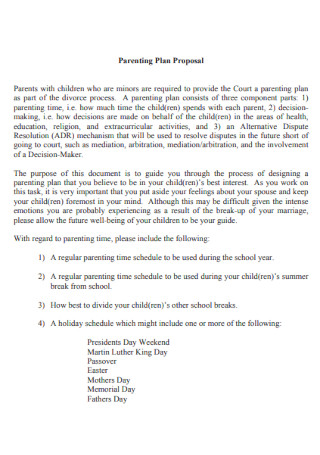
Parenting Plan Proposal Template
download now -
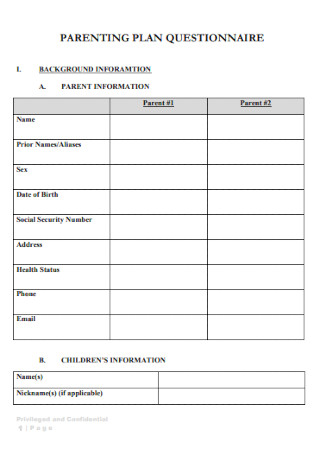
Parenting Plan Questionnaire
download now -

Partmanent Parenting Plan Template
download now -
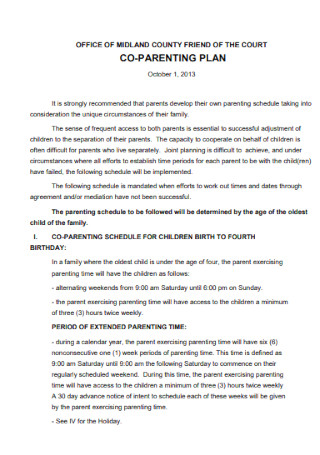
Sample Co-Parenting Plan Template
download now -
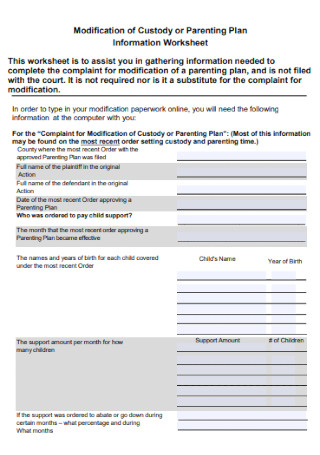
Modification of Custody or Parenting Plan
download now -
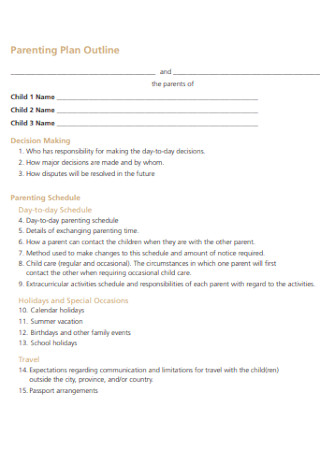
Parenting Plan Outline Example
download now -
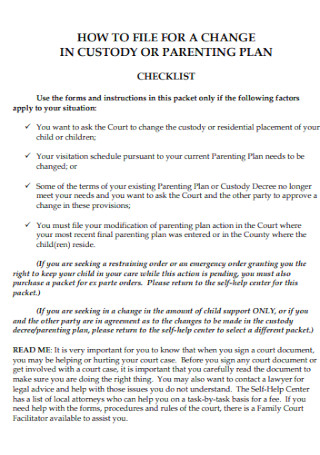
Custody and Parenting Plan Template
download now -
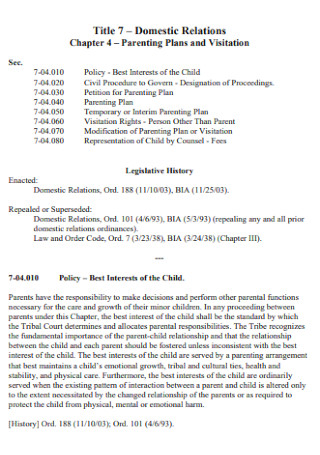
Parenting Plans and Visitation Template
download now -
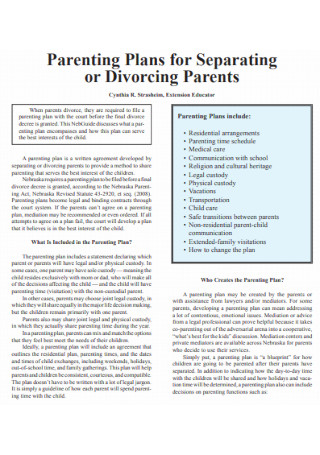
Parenting Plan for Separating Template
download now -

Child Up Parenting Plan
download now
FREE Parenting Plan s to Download
33+ Sample Parenting Plan Templates
What Is a Parenting Plan?
Subject Matters to Discuss in a Parenting Plan
How to Craft an Acceptable Parenting Plan
FAQs
What happens when you violate a parenting plan?
What is the most typical child custody arrangement?
Are text messages useful in a custody court?
What Is a Parenting Plan?
While legal terms “custody” and “visitation” were commonly used in courtroom sessions, court systems eventually associated with family-friendly or appropriate terminologies, including parenting plans. That is, according to HG.org. But what exactly is it? Parenting plans are another term for child custody agreement plans. With this, couples negotiate particular agreements about how to raise their kids. To be more specific, such a scheme aims to share parental responsibilities even when parents are no longer married. Expect this proposal during marital separation or divorce. Also, the law requires married couples or those who are still cohabitating to have this method as preparation for the worst circumstances.
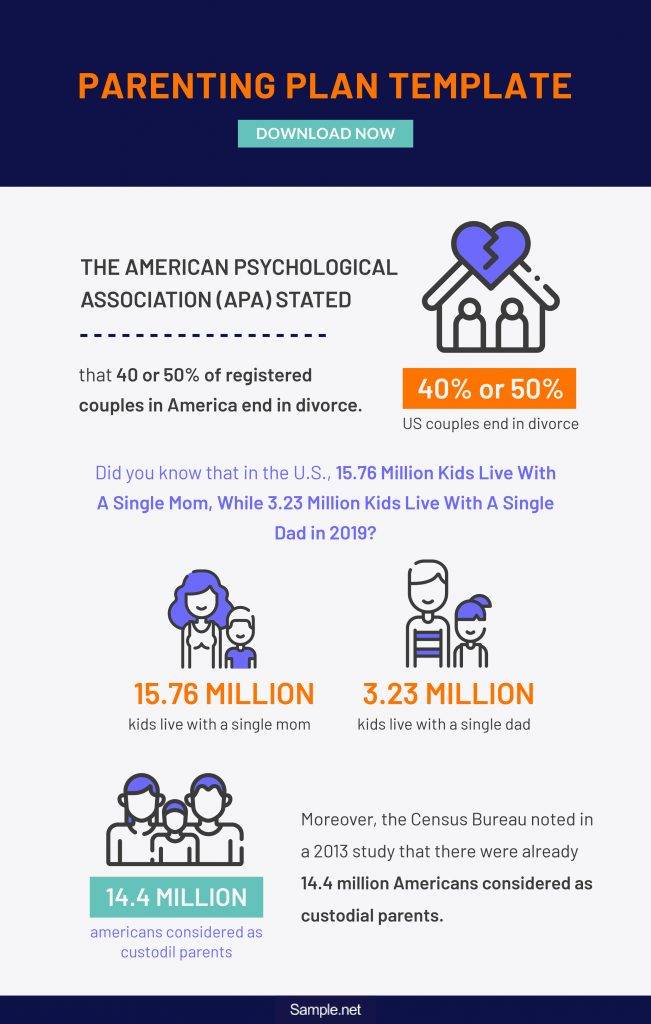
The American Psychological Association (APA) stated that 40 or 50% of registered couples in America end in divorce.
Did you know that in the US, 15.76 million kids live with a single mom, while 3.23 million kids live with a single dad in 2019?
Moreover, the Census Bureau noted in a 2013 study that there were already 14.4 million Americans considered custodial parents.
Why Are Parenting Plans Important?
Why is a parenting plan essential, you may ask? Go back to how it focuses on children. Without plans set for the young, they would lack financial support, education, food, and parental guidance. Despite parents breaking up, working together on the custody arrangement is one of the positive effects a parenting plan gives. A harmonious agreement is much better than ending with arguments that will lead to serious litigation in court. More so, the scheme tackles how many times a parent can visit a child, how to communicate on essential matters, and how much the budget is for child maintenance.
Also, parenting plans are less expensive than litigation. In case parents have a hard time agreeing with each other, resolution methods apply anyway, including mediation and arbitration. Thus, a third party can help decide for a better solution. These proposals are flexible, so incorporating numerous solutions is encouraged. With clarified guidelines regarding how to conduct parenting, the kids will be on good terms despite being in separate long-distance households.
How Are Parenting Plans Negotiated?
In America, the majority of divorces do not happen inside courtrooms. Instead, many prefer negotiations outside by ending in a divorce settlement agreement. To come up with a reasonable deal, parents undergo independent consultation. Or perhaps, with mediation and negotiations handled by family law attorneys. Others even go for a notarized form to boost the plan’s validity. Nevertheless, the final option for parties, when they cannot meet children’s mutual interests, is to allow the court to take over.
Subject Matters to Discuss in a Parenting Plan
Since the US is known to have a 40 to 50% chance of couples ending in divorce, authorities established methods to prepare for such unforeseen circumstances. An example is the requirement of a prenuptial agreement before even getting married. Of course, parenting plans are part of such solutions. But what are the common topics discussed in that proposal? Here are the common subjects to discuss inside the parenting plan:
How to Craft an Acceptable Parenting Plan
The Census Bureau informed us that 14.4 million Americans are labeled custodial parents in a 2013 research survey. Moreover, Statista shared that 15.76 million kids have single mothers, whereas 3.23 million children have single fathers. With these statistics alone, it is safe to say that many people do not live in a perfect marriage. Even though relationships did not work out, perfecting the parenting plan is still vital. Hence, maintaining the children’s well-being as the central issue matters here. And how do you create a standard parenting plan? Simply follow these steps:
Step 1: Write Down the Parties’ Information
First things first, identify who is part of the parenting plan. Of course, this tells you to name the parents and the child. Aside from the names, input the rest of the basic information from birth dates, contact numbers, addresses, and the like. Any plan requires the parties’ details for formality and identification purposes. Make sure only to write accurate information and check the spelling.
Step 2: Note the Guidelines
As parents come up with an agreement through this plan, guidelines become necessary. How will each party know which is the right thing to do or not anyway? Ensure adherence to all rules and regulations by stating the provisions, requirements, or restrictions. Otherwise, the plan is null.
Step 3: Define the Care Arrangement
Now for the main course of the document. Input the care arrangement details. Are you wondering what content should be inside here? Recall those subject matters commonly found in parenting plans that we discussed earlier. Those are the topics needed in this section of the document. Such an arrangement fully describes the whole tasks involving the kids’ care and upbringing. Clarify how tasks are divided among parents and in which both parents must agree.
Step 4: Specify the Parental Responsibilities
Expound further the arrangements by detailing every parental responsibility to fulfill. Remember that if one parent does not have a responsibility here, then the plan itself is wholly an access arrangement. What is an access arrangement? It is when the mother or father is no longer responsible for the child’s upbringing; however, he or she can still communicate with the child.
Step 5: Consider Entry by a Court
Most of the time, parenting plans come with consent, whether it is stipulated or endorsed. Such a policy is quickly approved when the entire scheme itself is stipulated. Furthermore, it should be consistent enough to reach the best interest of the kids. Thus requiring parties to be present in court. Courtroom activities are nothing to be scared of since they only aim to lessen the inconvenience and stress behind separation. Having the right authorities to guide you is a step closer to familiarizing yourself with the whole setup. Lastly, both partners must sign the form for compliance.
FAQs
What happens when you violate a parenting plan?
In violating a parenting plan which the court already agreed or ordered upon, it only puts the risk of litigation. Legal consequences, relating to custody and visitation, may follow as well. However, consequences may differ depending on what is stipulated under the agreement plan. Review the form’s guidelines regarding such violations then.
What is the most typical child custody arrangement?
Joint custody marks as the most common example of a custody arrangement. This example allows parents to work together in making significant decisions for the good of the child. Also, it grants a fair share of spending time with kids. Additionally, joint custody covers education, medical care plan, religion, and other related topics.
Are text messages useful in a custody court?
In California, having the other party send text messages that are useful for your case can be allowed in court. But, it involves particular exceptions. An example is when such messages contain important revelations or threats which help in undermining the latter’s case.
Matt Walsh once said, “Parenting is the easiest thing to have an opinion on, but the hardest thing in the world to do.” By that statement, it tells us that parenting is more than loving each other. Even when parents break up, they still have responsibilities to care for the young. There is no need to compete when co-parenting anyway. It is supposed to be a collaboration to guide kids in their best interests. Using a well-thought-out parenting plan guides you in your child’s good upbringing.
